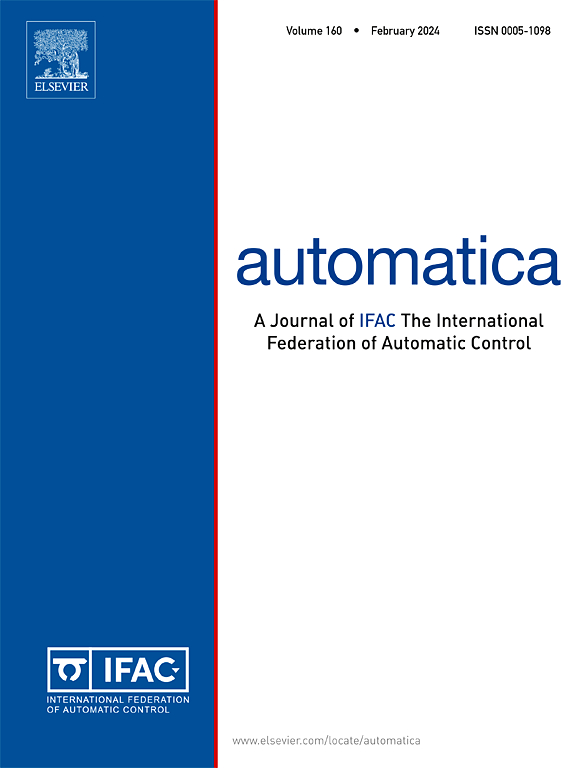Secure state constraints control design for uncertain nonlinear systems via a unified boundary modification approach
IF 4.8
2区 计算机科学
Q1 AUTOMATION & CONTROL SYSTEMS
引用次数: 0
Abstract
This paper investigates the tracking control problem of uncertain nonlinear systems under secure full-state constraints. Existing results implicitly assume that the constraints are reasonable and feasible control strategy capable of maintaining such constraints exists, which is unrealistic, especially for uncertain nonlinear systems, pre-determining the controllable attractor domain poses a challenge. In this paper, we present a unified boundary modification approach, which addresses the incompatibility problem between state constraints and ensures the secure operation of the system. First, we complete the direct constraints on the states using nonlinear state-dependent functions, where constraints comprise two components: (1) user-specified boundaries and (2) dynamic modification part. Then, we construct detection variables to determine whether the system loses control due to incompatible constraints. When the system enters the collision avoidance region, the dynamic adjustment function automatically corrects the constraints to ensure controllability and stability. The dynamic adjustment function remains inactive when the system operates within the safe region. Thus, existing state constraint results are a special case of ours. Moreover, we introduce a novel transformation so that the initial conditions of virtual controller are not restricted by the barrier function. The solution is more flexible in design and implementation, and the tracking error is confined within the specified performance envelope. Finally, numerical simulations validate the effectiveness of the approach.
通过统一边界修正法实现不确定非线性系统的安全状态约束控制设计
本文研究了安全全状态约束下不确定非线性系统的跟踪控制问题。现有结果隐含地假设了约束是合理的,并且存在能够维持这种约束的可行控制策略,这是不现实的,尤其是对于不确定的非线性系统,预先确定可控吸引域是一个挑战。本文提出了一种统一的边界修正方法,既解决了状态约束之间的不相容问题,又确保了系统的安全运行。首先,我们使用非线性状态相关函数完成对状态的直接约束,其中约束包括两个部分:(1) 用户指定边界和 (2) 动态修改部分。然后,我们构建检测变量,以确定系统是否因不兼容约束而失去控制。当系统进入避免碰撞区域时,动态调整功能会自动修正约束条件,以确保可控性和稳定性。当系统在安全区域内运行时,动态调整功能保持不活动。因此,现有的状态约束结果是我们的特例。此外,我们还引入了一种新颖的变换,使虚拟控制器的初始条件不受障碍函数的限制。该解决方案在设计和实施上更加灵活,跟踪误差也被限制在指定的性能包络线内。最后,数值模拟验证了该方法的有效性。
本文章由计算机程序翻译,如有差异,请以英文原文为准。
求助全文
约1分钟内获得全文
求助全文
来源期刊

Automatica
工程技术-工程:电子与电气
CiteScore
10.70
自引率
7.80%
发文量
617
审稿时长
5 months
期刊介绍:
Automatica is a leading archival publication in the field of systems and control. The field encompasses today a broad set of areas and topics, and is thriving not only within itself but also in terms of its impact on other fields, such as communications, computers, biology, energy and economics. Since its inception in 1963, Automatica has kept abreast with the evolution of the field over the years, and has emerged as a leading publication driving the trends in the field.
After being founded in 1963, Automatica became a journal of the International Federation of Automatic Control (IFAC) in 1969. It features a characteristic blend of theoretical and applied papers of archival, lasting value, reporting cutting edge research results by authors across the globe. It features articles in distinct categories, including regular, brief and survey papers, technical communiqués, correspondence items, as well as reviews on published books of interest to the readership. It occasionally publishes special issues on emerging new topics or established mature topics of interest to a broad audience.
Automatica solicits original high-quality contributions in all the categories listed above, and in all areas of systems and control interpreted in a broad sense and evolving constantly. They may be submitted directly to a subject editor or to the Editor-in-Chief if not sure about the subject area. Editorial procedures in place assure careful, fair, and prompt handling of all submitted articles. Accepted papers appear in the journal in the shortest time feasible given production time constraints.
 求助内容:
求助内容: 应助结果提醒方式:
应助结果提醒方式:


